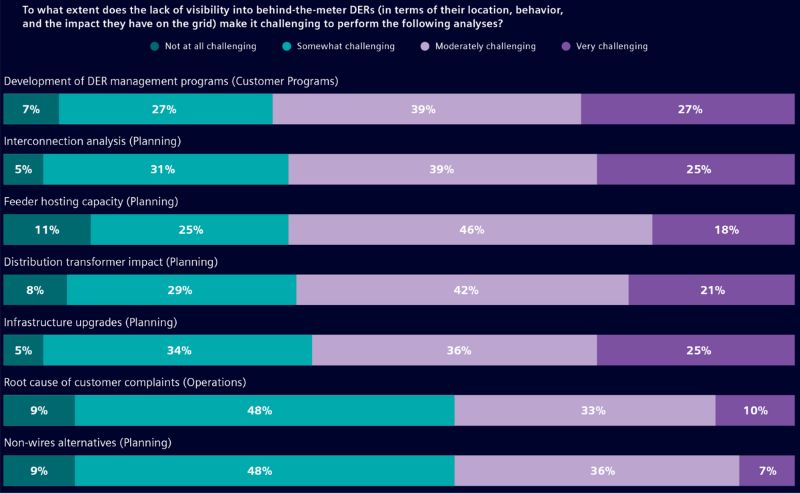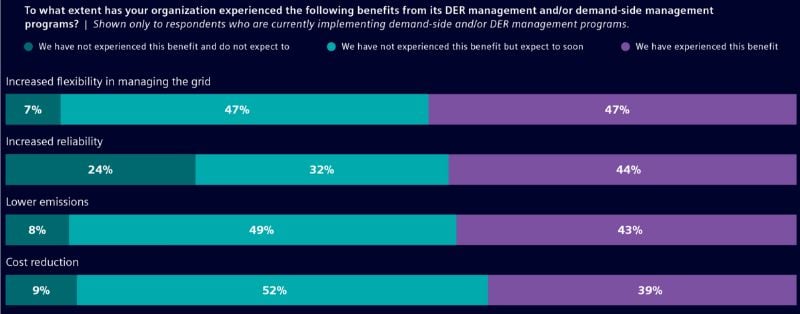In the Dark: Limited DER Data Causes Grid Ops Challenges
Behind-the-meter distributed energy resources like home electric vehicle chargers and solar panels offer opportunities for boosting grid flexibility. That is, if utilities can access consumption and location data. A recent survey reveals ongoing challenges.
As more on-site solar panels, electric vehicle (EV) charging infrastructure, and battery storage systems join the power grid, utilities can tap into user-side distributed energy resources (DER) for load flexibility and demand response functions. However, a survey commissioned by German tech giant Siemens highlights a critical hurdle: Many utilities have little to no visibility into the location and behaviors of customers’ DER.
Only 14% of the survey’s 100 utility leaders reported having access to all behind-the-meter (BTM) DER locations on their grids, and only 20% could see all BTM load and generation data. Likewise, a combined 39% said they have zero visibility into either metric.
The growing adoption of DERs brings new challenges for distribution grids. Image used courtesy of Siemens
Without visualizing all DERs in the network, utilities cannot conduct interconnection analyses to forecast the likely impacts of DER on their feeders, transformers, and substations, nor can they plan infrastructure upgrades to prevent performance losses.
Nearly 75% of respondents said increased DER penetration causes significant operational and performance challenges. More than half cited voltage visibility and control issues, 49% reported back-feeding, and 42% noted protection and control coordination. Other problems include distribution transformer and conductor overloads (39%) and masked or hidden loads (24%).
Utilities only have access to some information on BTM DER locations and usage. Image used courtesy of Siemens (Figure 2)
The survey involved 100 executives, managers, supervisors, and other leaders responsible for decision-making at U.S. and Canadian utilities. The results corroborate previous findings by the International Energy Agency, reporting that DERs are primarily invisible and can’t be controlled by grid operators.
What Are Behind-the-Meter DERs?
BTM DERs generate and store electricity from on-site solar panels, stationary storage installations, bidirectional EV chargers, and other home battery systems, such as Tesla’s Powerwall. As the name suggests, BTM resources connect to the distribution system through the user’s side of the electric meter. Front-of-the-meter systems work in the other direction, with power passing through the meter on the company’s side before reaching the customer.
More than half of utilities in the Siemens survey said they’ve experienced the growing adoption of BTM solar panels (64%), EVs (50%), and batteries (37%) since 2020. They foresee further expansion over the next three years: 87% for solar, 78% for EVs, and 59% for batteries.
Wood Mackenzie estimates BTM capacity will rise 3.7 times more by 2027 than in the last five years. While distributed solar has historically claimed the highest BTM capacity, the next decade will add significant battery storage and EV charging infrastructure to the grid. More than 260 GW of new DER and demand flexibility capacity will be installed by 2027, almost as much as the 272 GW of utility-scale resources expected to be added.
Grid Operational Challenges from Limited Data
Traditional distribution grids often struggle to handle the two-way power flow of BTM DERs. As a result, utilities are seeing frequent overloads and overvoltages in feeders and transformers, shortening their equipment life. For instance, when power flows from a customer’s rooftop solar panel to the grid, power line capacity could overflow and cause grid congestion.
Operational challenges caused by limited behind-the-meter visibility. Image used courtesy of Siemens (Figure 3)
Utilities can mitigate these issues with insights into BTM DER locations and usage patterns. One way to get this information is through demand response programs, which incentivize users to limit consumption during peak hours and sell the excess energy back to the utility. More than two-thirds of those surveyed are adopting demand-side initiatives.
DER management programs are another option. Utilities work with grid operators to manage DER and balance demand and supply. Only 37% of respondents have implemented these programs, which come with the downside of requiring customers to opt in. They’re less popular (with 35% participation) than demand-side programs offering incentives (54%).
Advantages of demand-side and DER management programs. Image used courtesy of Siemens (Figure 5)
Alternatively, utilities can use distributed energy resource management systems (DERMS) to gain more visibility. DERMS software allows utilities to analyze, forecast, and visualize DER assets. More than half of respondents said they could access behavior data on BTM DERs connected to their DERMS or a similar platform, but only 12% reported the same for location information.
Relatedly, Siemens recently released a software program addressing many of these issues. Gridscale X DER Insights uses load disaggregation algorithms to detect BTM DER connections at the distribution level. It also analyzes aggregate data up to the circuit and substation transformer.
A screenshot from Siemens’ Gridscale X DER Insights platform. Image used courtesy of Siemens
In building a digital representation of all BTM DER connections, the software boasts a 75% reduction in transformer costs, a 50% reduction in maintenance, and a twofold increase in capacity across existing assets.











